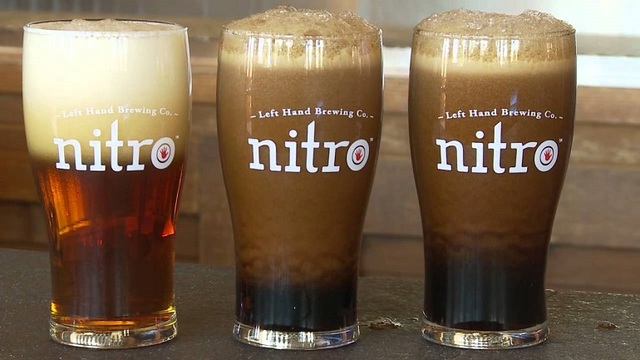Craft beer, like any other market, is full of fads and offerings to differentiate one beer from another. Some fads come and go with a whisper others stay around and continue to build in popularity. One such fad is the addition of nitro, or nitrogen, in beer.
While this may not technically be a fad in the truest sense of the term, after all, Guinness has offered its popular stout on nitro for decades. However, the addition of nitro to a wide variety of beer styles, instead of the common stout, has been building with nearly every beer style having over the past few years. What exactly is nitro and what is it doing to our beer? Does it make the beer better?
Let’s get scientific to better understand the difference. Standard beers offer the refreshingly prickly CO2 bubbles common in beer. CO2 is a natural bi-product in the beer-making process. As beer ferments, yeast consume sugars in the wort and produce two bi-products: alcohol (yay!) and CO2. Beer is often force-carbonated as well to give it that wonderful bubbly mouthfeel.
The amount of CO2 in beer varies on style, but the perfect balance is always sought to create the best beer possible. CO2 should be controlled in beer once you grab a six pack to bring home. Keep the beer cool, but not too cold otherwise it stifles the CO2 and if it’s stored too warm, you may have a mess on your hands when you pry off the cap.
If you tried a beer with nitro then you know that it has a reduced amount of CO2 in the beer and creates much finer bubbles. These smaller bubbles dramatically change the mouthfeel of the beer and impart a full and smooth texture to any beer.
Typically most beers that are put through this process have a ratio of 70 percent nitrogen and 30 percent CO2. This ratio helps the beer to still feel carbonated, but adds a very different experience.
As the popularity of nitrogen in beers grows brewers have evolved ways of adding nitro to beer for bottling and canning. Guinness had canned its popular stout on nitro through the use of a widget that would be left to rattle around in the can. Brewers discovered new ways to can or bottle without a widget.
If you had a nitro beer on tap at a local bar that is done through a different process. Bars have a system set up with nitrogen that mixes with the beer as it is poured. The trick with these systems is getting the proper balance of gas to dispense into the beer, which is why you see many bars have one tap dedicated to nitro beers as it makes it easier to not continuously have to adjust the gas as it is moved to different taps.
Left Hand Brewing made news when it released bottles of its popular Milk Stout on nitro. The beer was bottled with no widget or gadget inside and was just a “normal” beer in a bottle that poured like a nitro beer.
Speaking of pouring, this is another big difference between nitro and standard beers. If you pour a standard beer from a bottle aggressively, you have beer that quickly overflows leaving half of the contents on your counter. With nitro beers you can be extremely aggressive with your pour and the beer will not quickly rise and overflow.
CO2 has larger bubbles compared to the nitrogen beer’s smaller bubbles. These bubbles are the gas and as they pour they are stirred up and are looking to move around. The nitro beers are smaller and not as aggressive which leads to very smooth pours that are fun to watch.
More delicate beers, such as many Belgian styles, would not benefit from being put on nitro as the process would muffle many of the subtle nuances from the flavors. Thick stouts and porters gain huge benefits from the nitro process that enhance the malt character and bring forward bold flavors.





